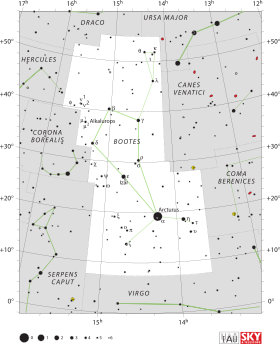Sigma Boötis
Sigma Boötis (σ Boo, σ Boötis) is a star in the constellation Boötes.
 | |
| Observation data Epoch J2000 Equinox J2000 | |
|---|---|
| Constellation | Boötes |
| Right ascension | 14h 34m 40.81699s[1] |
| Declination | +29° 44′ 42.4590″[1] |
| Apparent magnitude (V) | 4.46[2] |
| Characteristics | |
| Spectral type | F4VkF2mF1[3] |
| U−B color index | −0.084[2] |
| B−V color index | +0.366[2] |
| R−I color index | 0.19 |
| Variable type | suspected[4] |
| Astrometry | |
| Radial velocity (Rv) | +0.37±0.09[5] km/s |
| Proper motion (μ) | RA: +188.35[1] mas/yr Dec.: +131.77[1] mas/yr |
| Parallax (π) | 63.16 ± 0.25[1] mas |
| Distance | 51.6 ± 0.2 ly (15.83 ± 0.06 pc) |
| Absolute magnitude (MV) | 3.52[6] |
| Details | |
| Mass | 1.48[7] M☉ |
| Radius | 1.431±0.023[8] R☉ |
| Luminosity | 3.461±0.042[8] L☉ |
| Surface gravity (log g) | 4.30[6] cgs |
| Temperature | 6,594±55[8] K |
| Metallicity [Fe/H] | −0.24[9] dex |
| Rotational velocity (v sin i) | 7.32[10] km/s |
| Age | 1.7[11] Gyr |
| Other designations | |
| Database references | |
| SIMBAD | data |
| Data sources: | |
| Hipparcos Catalogue, CCDM (2002), Bright Star Catalogue (5th rev. ed.) | |
| Database references | |
| SIMBAD | data |
Sigma Boötis is a yellow-white F-type main sequence dwarf with an apparent magnitude of +4.47. It is approximately 50.4 light years from Earth.
In Chinese, 梗河 (Gěng Hé), meaning Celestial Lance, refers to an asterism consisting of σ Boötis, ε Boötis and ρ Boötis.[12] Consequently, the Chinese name for σ Boötis itself is 梗河二 (Gěng Hé èr, English: the Second Star of Celestial Lance.)[13]
Located to the southeast of Rho Boötis, the dwarf Sigma may at first appear as a naked-eye double, but the angular proximity with Rho is merely line-of-sight. Like many of its spectral class, Sigma is apparently a variable of the Delta Scuti variety, which vary subtly with multiple periods of hours.
Infrared surveys with the Spitzer and Herschel space telescopes failed to detect an infrared excess around this star at wavelengths up to 160 μm. However, the HOSTS Survey with the Large Binocular Telescope reported a detection of an excess in the far infrared, indicating the presence of exozodiacal dust near the habitable zone of the star.[14]
References
- van Leeuwen, F. (2007), "Validation of the new Hipparcos reduction", Astronomy and Astrophysics, 474 (2): 653–664, arXiv:0708.1752, Bibcode:2007A&A...474..653V, doi:10.1051/0004-6361:20078357.
- Elliott, J. E. (October 1974), "Study of delta Scuti variables" (PDF), Astronomical Journal, 79: 1082–1090, Bibcode:1974AJ.....79.1082E, doi:10.1086/111657.
- Gray, R. O.; et al. (April 2001), "The Physical Basis of Luminosity Classification in the Late A-, F-, and Early G-Type Stars. I. Precise Spectral Types for 372 Stars", The Astronomical Journal, 121 (4): 2148–2158, Bibcode:2001AJ....121.2148G, doi:10.1086/319956.
- Samus, N. N.; Durlevich, O. V.; et al. (2009). "VizieR Online Data Catalog: General Catalogue of Variable Stars (Samus+ 2007-2013)". VizieR On-line Data Catalog: B/gcvs. Originally Published in: 2009yCat....102025S. 1. Bibcode:2009yCat....102025S.
- Nidever, David L.; et al. (August 2002), "Radial Velocities for 889 Late-Type Stars", The Astrophysical Journal Supplement Series, 141 (2): 503–522, arXiv:astro-ph/0112477, Bibcode:2002ApJS..141..503N, doi:10.1086/340570.
- Paunzen, E.; et al. (July 2014), "Investigating the possible connection between λ Bootis stars and intermediate Population II type stars", Astronomy & Astrophysics, 567: 8, arXiv:1406.3936, Bibcode:2014A&A...567A..67P, doi:10.1051/0004-6361/201423817, A67.
- David, Trevor J.; Hillenbrand, Lynne A. (2015), "The Ages of Early-Type Stars: Strömgren Photometric Methods Calibrated, Validated, Tested, and Applied to Hosts and Prospective Hosts of Directly Imaged Exoplanets", The Astrophysical Journal, 804 (2): 146, arXiv:1501.03154, Bibcode:2015ApJ...804..146D, doi:10.1088/0004-637X/804/2/146.
- Boyajian, Tabetha S.; et al. (February 2012), "Stellar Diameters and Temperatures. I. Main-sequence A, F, and G Stars", The Astrophysical Journal, 746 (1): 101, arXiv:1112.3316, Bibcode:2012ApJ...746..101B, doi:10.1088/0004-637X/746/1/101. See Table 10.
- Bensby, T.; et al. (2014), "Exploring the Milky Way stellar disk. A detailed elemental abundance study of 714 F and G dwarf stars in the solar neighbourhood", Astronomy & Astrophysics, 562 (A71): 28, arXiv:1309.2631, Bibcode:2014A&A...562A..71B, doi:10.1051/0004-6361/201322631.
- Martínez-Arnáiz, R.; et al. (September 2010), "Chromospheric activity and rotation of FGK stars in the solar vicinity. An estimation of the radial velocity jitter", Astronomy and Astrophysics, 520: A79, arXiv:1002.4391, Bibcode:2010A&A...520A..79M, doi:10.1051/0004-6361/200913725.
- Decin, G.; et al. (November 2003), "Age Dependence of the Vega Phenomenon: Observations", The Astrophysical Journal, 598 (1): 636–644, arXiv:astro-ph/0308294, Bibcode:2003ApJ...598..636D, doi:10.1086/378800
- (in Chinese) 中國星座神話, written by 陳久金. Published by 台灣書房出版有限公司, 2005, ISBN 978-986-7332-25-7.
- (in Chinese) AEEA (Activities of Exhibition and Education in Astronomy) 天文教育資訊網 2006 年 6 月 29 日
- Ertel, S.; et al. (May 2018), "The HOSTS Survey—Exozodiacal Dust Measurements for 30 Stars", The Astronomical Journal, 155 (5): 19, arXiv:1803.11265, Bibcode:2018AJ....155..194E, doi:10.3847/1538-3881/aab717, 194.